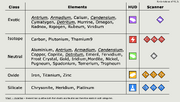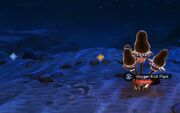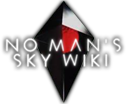| The subject of this article is from the Atlas Rises update.
The information from this article is up-to-date as of 23 July, 2018. |
The information from this article is up-to-date as of 23 July, 2018.

| This article is about the Atlas Rises version of Resource. For the NEXT version, see Resource. |
Resources are the primary materials for multi-tool, starship, exosuit and exocraft upgrades, as well as base building.
Summary[ | ]
Resources in No Man's Sky are organized in a periodic table custom made for the game. When resources are mined, they are broken down into their chemical elements, and these can be combined into new products, resources, etc. and sold on the open market.
Technology is dependent on certain elements, so collecting element resources and alloys can unlock new multi-tools, starships, etc.
Resources can be obtained in a wide variety of ways. They can be purchased, mined from raw elements on the ground of planets (either by hand or with an AMU), mined from asteroids in space, harvested from plants, given to you as gifts from animals you befriend, found in crates and containers on planet surfaces, and harvested by killing plants or animals or mining mineral formations. The abundance of elements varies significantly from one planet to another, and some resources are easiest to obtain in specific ways.
Scanning[ | ]

Scanner and HUD icons

Scanner "diamonds"
When the scanner is used on a planet, diamonds of red, yellow, blue, green, and purple are displayed after the scan. These colors represent the location of elements belonging to the element groups indicated below. Resources of common rarity will not have the diamond markers. All mineable nodes (chunks of minerals in rock form) will have grids outlining the parts that will give resources when mined. Nodes that do not have grids DO NOT give resources when mined.
Scanning rock formations, crystals and flora with the Analysis Visor can reveal secondary resources, which can then be mined on all other instances of that scanned object.
Elements[ | ]
There are five groups of elements: Oxides, Isotopes, Silicates, Neutrals, and Exotic elements. There are also four elements that are members of the Neutral/Exotic elements family that show characteristics of both the Neutral and Exotic groups.
Following the Atlas Rises update, harvesting elements from the terrain, plants, and animals can also supply a small chance to receive any of the elements below as a secondary resource (excluding items under the "Other Resources" lists below). The secondary elements are listed when scanning elements.
The following table contains:
- 19 elements present in the initial release
- 14 elements added as part of Update 1.10 (Foundation)
- 2 elements added as part of Update 1.20 (Pathfinder)
It does not contain alloys or other crafted products. (A list of alloys follows this table.)
Note that each individual resource page contains a list of items where the resource is an ingredient. As of the Atlas Rises update, the only resources that are NOT used in crafting are Pugneum, Tropheum, and Murrine.
| Icon | Element | Abbrev | Group | Rarity | Base value units | Released |
|---|---|---|---|---|---|---|
 |
Iron | Fe | Oxide | Common | 14.0 | 1.0 |
 |
Zinc | Zn | Oxide | Uncommon | 41.0 | 1.0 |
 |
Titanium | Ti | Oxide | Rare | 62.0 | 1.0 |
 |
Heridium | Hr | Silicate | Common | 28.0 | 1.0 |
 |
Platinum | Pt | Silicate | Uncommon | 55.0 | 1.0 |
 |
Chrysonite | Ch | Silicate | Rare | 83.0 | 1.0 |
 |
Carbon | C | Isotope | Common | 7.0 | 1.0 |
 |
Thamium9 | Th | Isotope | Uncommon | 21.0 | 1.0 |
 |
Plutonium | Pu | Isotope | Rare | 41.0 | 1.0 |
 |
Nickel | Ni | Neutral | Common | 138.0 | 1.0 |
 |
Copper | Cu | Neutral | Uncommon | 110.0 | 1.0 |
 |
Iridium | Ir | Neutral | Uncommon | 96.0 | 1.0 |
 |
Aluminium | Al | Neutral | Rare | 165.0 | 1.0 |
 |
Coprite | Cr | Neutral | Rare | 30.0 | 1.1 |
 |
Frost Crystal | Fc | Neutral | Rare | 12.0 | 1.1 |
 |
Emeril | Em | Neutral | Rare | 275.0 | 1.0 |
 |
Solanium | So | Neutral | Rare | 70.0 | 1.1 |
 |
Gold | Au | Neutral | Rare | 220.0 | 1.0 |
 |
Mordite | Mo | Neutral | Rare | 40.0 | 1.1 |
 |
Pugneum | Pg | Neutral | Rare | 138.0 | 1.1 |
 |
Cactus Flesh | Cc | Neutral | Rare | 28.0 | 1.1 |
 |
Fungal Mould | Fm | Neutral | Rare | 16.0 | 1.1 |
 |
Tropheum | Tr | Neutral | Rare | 138.0 | 1.1 |
 |
Radnox | Ra | Precious/Exotic | Very Rare | 303.0 | 1.0 |
 |
Marrow Bulb | Mb | Neutral/Exotic | Rare | 41.0 | 1.1 |
| Armadium | Ar | Neutral/Exotic | Rare | 27.5 | 1.2 | |
| Detritum | De | Neutral/Exotic | Rare | 27.5 | 1.2 | |
 |
Gamma Root | Gr | Neutral/Exotic | Rare | 16.0 | 1.1 |
 |
Rubeum | Ru | Exotic | Rare | 289.0 | 1.1 |
 |
Kelp Sac | Ke | Exotic | Rare | 41.0 | 1.1 |
 |
Viridium | Vi | Exotic | Rare | 303.0 | 1.1 |
 |
Calium | Ca | Exotic | Very Rare | 289.0 | 1.0 |
 |
Cymatygen | Cy | Exotic | Very Rare | 275.0 | 1.1 |
 |
Murrine | Mu | Exotic | Very Rare | 303.0 | 1.0 |
 |
Omegon | Om | Exotic | Very Rare | 309.0 | 1.0 |
Compressed Atmospheric Gas[ | ]
These can be collected with an Atmosphere Harvester or as a secondary element on certain plants after being scanned.
| Icon | Element | Abbrev | Base value units | Environment | Released |
|---|---|---|---|---|---|
 |
Sulphurine | Su | ? | Hot/Barren | 1.3 |
 |
Radon | Rn | ? | Radioactive/Frozen | 1.3 |
 |
Nitrogen | N | ? | Lush/Toxic | 1.3 |
Resource Deposits[ | ]
Resource Deposits are concentrated nodes of a certain element. There are always two resource deposit types of any kind plus Heridium on every planet (e.g. Copper and Aluminium).
- Heridium nodes are tall, thin, deep blue and cuboid shaped.
- Nickel nodes are similar to the Heridium nodes, except that they are wider, smaller and have a dark color.
- Aluminium nodes are wider, smaller than Heridium nodes, are also rounded (have a half-disk like shape) and have a metallic white color.
- Emeril nodes have a metallic green color and are shaped like a really rough half-sphere.
- Gold nodes have a metallic yellow color, and are similar in shape to Emeril.
- Copper nodes are usually shaped like eggs, are dark brown in color and float in the air.
- Iridium nodes are the rarest version of a node. They looks like a steep arc and can be easily confused with rocks in color.
- Rubeum nodes are only found in Red Star Systems.
- Viridium nodes are only found in Green Star Systems.
- Cymatygen nodes are only found in Blue Star Systems.
It is possible to find bigger nodes which contain more elements than usual. There's a chance that those nodes can be marked by scanning in space with a spaceship.
Crystals[ | ]
Some elements can also be found in crystalline form. The color of the crystal indicates which element family is present.
- Red crystals contain Plutonium and may contain Thamium9 as a secondary element. Most common.
- Blue crystals are Chrysonite, may contain Heridium. Rare.
- Yellow crystals are composed of Titanium, and may contain Iron. Rare.
- Green Crystals can contain any Neutral element. Very rare.
Plants[ | ]
Some elements can be found as compounds in certain plants on planet surfaces:
- Carbon (can also be found by killing animals)
- Zinc
- Platinum
- Thamium9
- Marrow Bulb (in caves)
- Cactus Flesh ( on desert worlds)
- Gamma Root (on radioactive worlds)
- Fungal Mould (on toxic worlds)
- Frost Crystal (on frozen worlds)
- Solanium (on hot worlds)
- Kelp Sac (underwater)
Additionally, these elements can be collected from fauna interactions, but can also be farmed:
Pre-Release elements[ | ]
The following elements and element abbreviations were used in the pre-release version of the game.
Additional information[ | ]
- During an interview with Sean Murray, he was asked how far down you can dig. Sean said "you can dig like 128 meters down into a planet." [1] This sets a limit on how deep mining and exploration can take place.
- When art director Grant Duncan wanted the possibility of green skies over a planet, the development team at Hello Games had to redesign the periodic table to create atmospheric particles that would diffract light at just the right wavelength.
Sean Murray commented during a gameinformer interview, "We just wanted to be a bit freer. There's only something like seven different compounds or something like that that we create really good types of liquids that you could have creatures survive in. And we might want more than that for the game. We might want to decide our own rules and you just get tied up into too many conversations about it and things like that. Sometimes gameplay and science don't sync together. That's sort of a shame but I think for the best."[2]
Gallery[ | ]
Giant flora allocations in the system of Ame on Ame Prime - Preteritor.jpg
References[ | ]
- ↑ Giant Bombcast (23 June 2015). 'Giant Bombcast - 1:10:00 mark'.
- ↑ Vore, Bryan (26 December 2014). [www.gameinformer.com/b/features/archive/2014/12/26/an-assortment-of-lesser-known-no-man-s-sky-facts.aspx An Assortment Of Lesser-Known No Man's Sky Facts]. gameinformer. Retrieved 19 July 2016.


